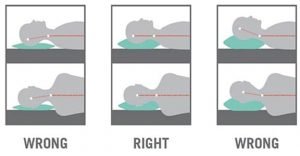
Sleeping Posture and Pillows
Sleeping Posture and Pillows

Read about sleep, pain and recovery here.
Adopting particular sleeping positions or using certain pillows can potentially reduce your neck, back, shoulder, hip and knee pain and assist you in achieving a better quality sleep.
Wondering what sleeping position and pillow is best for you? Let us explore the following options…
Sleeping On Your Back
This is the best position for most of us. Sleeping on your back allows your head, neck and spine to rest in a neutral alignment, reducing abnormal or uneven pressure.
Our neck has a natural curve, which should be maintained whilst lying down. Sleeping without a pillow under your head will help to maintain a neutral neck position, however it may be uncomfortable or take some time to get used to. If you require a pillow under your head, ensure that it is not too thick as your neck may be forced into an over-flexed position, causing extra stress on your muscles and joints. It is also important to place the pillow under your head, not your shoulders.
If you experience knee pain, especially when your legs are straightened, place a pillow horizontally under both of your knees to allow a slight bend. Placing a pillow underneath your knees may also be comfortable if you experience low back pain. When sleeping on your back, refrain from crossing your legs or sliding one knee over the other as this torsional force increases the pressure on your pelvis.
Although sleeping on your back is great for neutral spinal alignment, you are more likely to snore or experience sleep apnoea (a condition where breathing stops momentarily during sleep). If you experience these conditions, the next sleeping position will be better for you.
Sleeping On Your Side
Sleeping on your side tends to be best for pregnant women, those who snore and those who suffer with sleep apnea. Sleeping on your unaffected side also tends to be best for those of you who experience shoulder or hip pain.
In this position, more body weight is placed on your shoulder, which can place extra stress on your neck and shoulder muscles. Hence when buying a pillow, a memory foam pillow that conforms to the contour of your head and neck is recommended to maintain neutral spinal alignment. Your pillow should be thick enough so that your shoulder or neck is not compressed. If your pillow is too thin, your head will fall towards the mattress and cause uneven stress on your neck.
If you experience back pain and prefer to lie on your side, it is important to maintain a neutral lumbar spine by having a slight bend in your knees and placing a pillow between your knees. Pregnant women have reported that placing a pillow underneath their back and a pillow between their knees is the most comfortable for them.
Although sleeping on your side is the preferred sleeping position for some, it can restrict blood flow and compress nerves, which could result in a “dead arm” sensation, numbness or tingling in your arms and hands.
Sleping On Your Stomach
The only positive of sleeping on your stomach is that it may ease snoring. If you are sleeping on your stomach with your head turned to either side, significant stress is placed on your neck muscles and ligaments. This is not recommended especially if you experience neck pain.
These are 3 of the most common sleeping positions that can be adapted to better suit your needs. Book an appointment at Duncraig Physio to learn more.
- Sayar K, Arikan M, Yontem T (2002). Sleep Quality in Chronic Pain Patients. Can J Psychiatry. 47, 844-848.
- Smith MT, Haythornthwaite JA (2004). How do sleep disturbance and chronic pain inter-relate? Insights from the longitudinal and cognitive-behavioral clinical trials literature. Sleep Med Rev. 8(2), 119-32